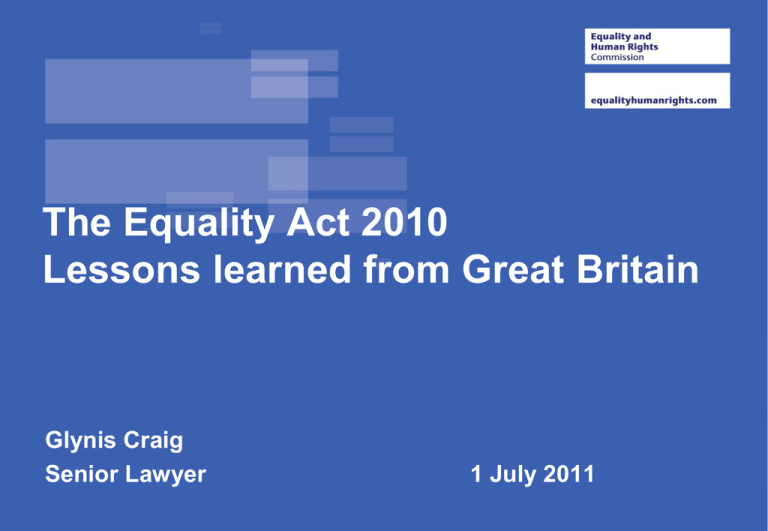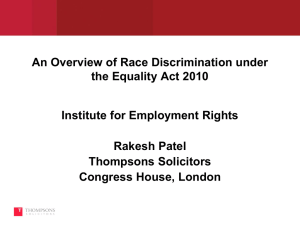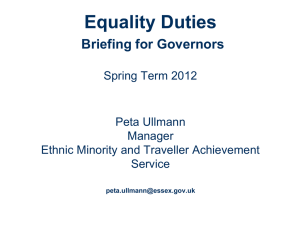
The Equality Act 2010
Lessons learned from Great Britain
Glynis Craig
Senior Lawyer
1 July 2011
The Evolution of the Act
Discrimination Law Review (DLR) launched Feb 2005
Equalities Review launched Feb 2005 to examine persistent inequalities
DLR consultation proposals June 2007 with three goals:
• Simplifying the law
• Harmonising the law across protected characteristics
• Making the law more effective e.g. Disability arising from discrimination,
disability and health questionnaires, increased scope (association); new
tribunal powers
The Evolution of the Act
Improvements to existing equality law were necessary to:
• Simplify : Replacing 40 years of discrimination law - 35 acts, 52
statutory instruments, 13 codes of practice, 16 EC directives with one
piece of legislation a large volume of equality legislation
• seeks to harmonise upwards the levels of protection
• Improve effectiveness: the Act creates enhanced mechanisms to
overcome systematic discrimination by improved public sector duties
and positive action measures
• Modernise: the Act introduces a range of new measures to
modernise equality law and make it fit for the 21st century
The Evolution of the Act
• 26 June 2008: Harriet Harman announced the government’s proposals
for the Equality Bill.
• 27 April 2009: the Government published the Equality Bill.
• 6 April 2010: the Equality Bill completed its parliamentary process, as
MPs approved all Lords amendments.
• 8 April 2010: the Bill received Royal Assent.
• 12 April 2010: Parliament dissolved pending General Election
The Key Achievements
The proposed improvements in the bill as enacted can be grouped as
follows:
-
Improved protection for particular groups
-
Increased scope of prohibited discrimination
-
New Public duties to reduce systemic inequality and discrimination;
-
Improved positive action provisions;
-
Improved powers of tribunals.
The Key Achievements
Improved protection for particular groups
Disabled people
Age groups
Women
Lesbian gay and bisexual people
Transsexual people
People with/without religious or philosophical beliefs
People from ethnic minorities
The Key Achievements
Increased scope of prohibited discrimination
Equality law has been modernised by the:
-
Extension of discrimination by association and perception to all
protected groups in relation to direct discrimination and harassment (this
includes carers);
-
Positive Action - On 6 April 2011 Provisions in the Equality Act 2010
related to positive action in recruitment and promotion were
commenced. These voluntary provisions cover the use of positive
action in matters of recruitment and employment and can be used by
an employer to address under-representation or other forms of
disadvantage within the workforce in a tie break situation
The Key Achievements
Improved powers of tribunals
In terms of changes practices in society, the Act has improved the powers
of Employment Tribunals. They will be able to:
-
provide remedies to the claimant;
-
Make recommendation to the employer for the benefit of the claimant;
-
Make recommendations to the employer which are directed at reducing
adverse impact on the wider workforce.
For example recommendations could be made to:
-
Introduce an equal opportunities policy;
-
Retrain staff on equality issues.
Public sector equality duty General duty
• Scheduled public authorities must, in the exercise of their
functions, have due regard to the need to – Eliminate discrimination, harassment, victimisation and
any other conduct prohibited by the Act
– Advance equality of opportunity
– Foster good relations
• Duty applies to bodies which are not public authorities but
which exercise public functions
What does ‘due regard’ mean?
• Advancing equality of opportunity
– Removing or minimising disadvantages experienced by persons
who share a protected characteristic
– Taking steps to meet the needs of persons who share a protected
characteristic
– Encouraging persons who share a protected characteristic to
participate in public life or other activity in which participation is
disproportionately low
• Good relations
– Tackling prejudice between groups
– Promoting understanding between groups
Specific duties
• Section 153 - Ministerial power to make regulations
impose specific duties to help public authorities meet their
‘general duty’
• The initial proposals for the specific duties –
– Transparency – public authorities required to publish data on
equality in relation to their workforce and services they provide
– Equality outcome objectives - public authorities will be required to
set equality outcome objectives, informed by the evidence and
data they publish
PSED Proposals- regression or
progression?
The existing PSED
The new PSED
• Applies to race, gender and
disability
• Emphasis on promoting
equality of opportunity and
good race relations
• Specific duties prescriptive
• Restricted to public
authorities and in relation to
disability bodies carrying out
public functions.
• Integrated - applies to all
protected characteristics
• Emphasis on advancing
equality of opportunity and
fostering good relations
• Specific duties less
prescriptive
• Applies to any body which
carries out a public function.
Specific Duties
-
Different nations have approached the matter differently. Welsh duties
in place. England and Scotland are awaiting new regs to be drafted.
- The Government say – “The new draft regulations will focus on
cutting bureaucracy and increasing transparency in order to free up
public bodies to do what is appropriate in their circumstances, to take
responsibility for their own performance and to be held to account by
the public”.
-
Courts are primarily interested in due regard and will not find that a
public authority has acted unlawfully because it has failed to follow the
regulations. However, failure to follow the regs can constitute evidence
that due regard has not been had.
Commencement of the Act
1 October 2010: Most of the Act came into force
• April 2011: single, integrated Public Sector Equality Duty –
Government consulting now on specific duties
• Government is still considering:
–
–
–
–
–
auxiliary aids in schools
age discrimination in services and public functions and associations
diversity reporting by political parties
Civil partnerships on religious premises
liability on employers for harassment of their employees by their
parties over whom they have no direct control
Not to be brought into force
• Provisions relating to dual discrimination
• The socio-economic duty
• Gender pay reporting measures. Government is working with
business to encourage the publication of equality workforce data
on a voluntary basis.
Areas of uncertainty/challenges
• Discrimination because of association with
someone who is perceived to have a protected
characteristic
• Harassment on grounds of sexual orientation,
religion and belief, pregnancy, maternity and
gender reassignment
• Proposing to undergo gender reassignment
• Gender recognition certificates and single sex
services/insurance
• Religion and belief GOR
• Exclusions - immigration
Conclusions
• Too early for cases reaching the higher courts
• The importance of political will
• Significant achievement and an important
piece of legislation to act as a model for other
jurisdictions.
‘Building a society built on fairness and
respect where people are confident in
all aspects of their diversity.’











